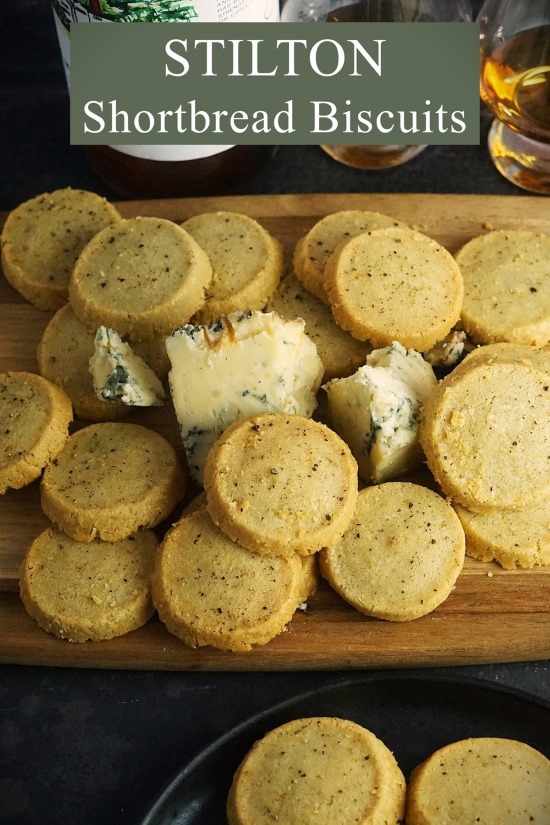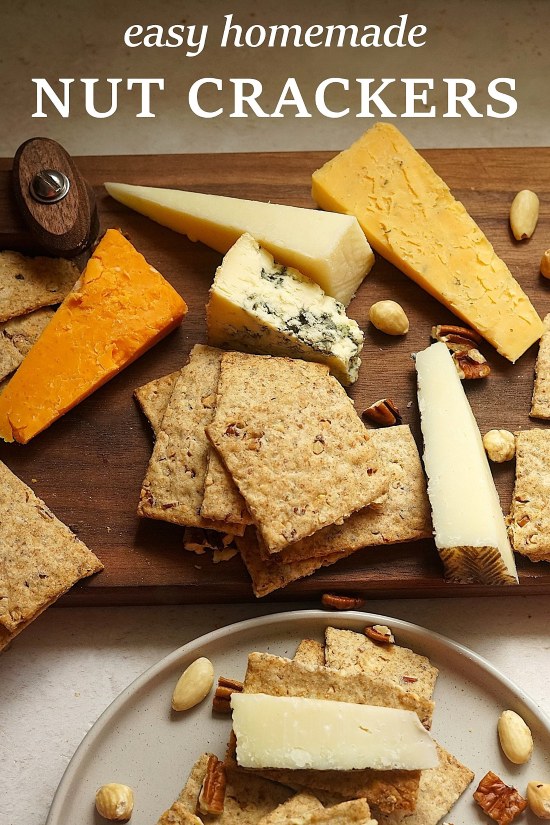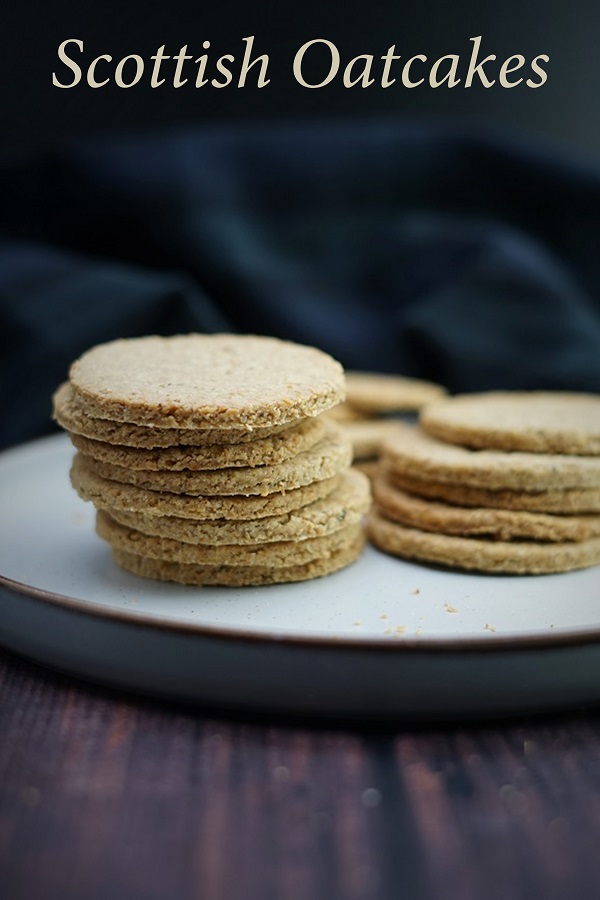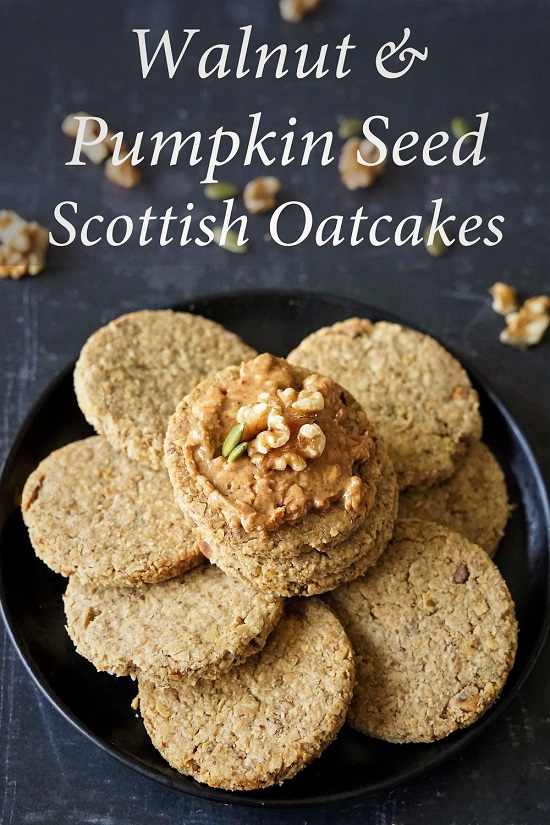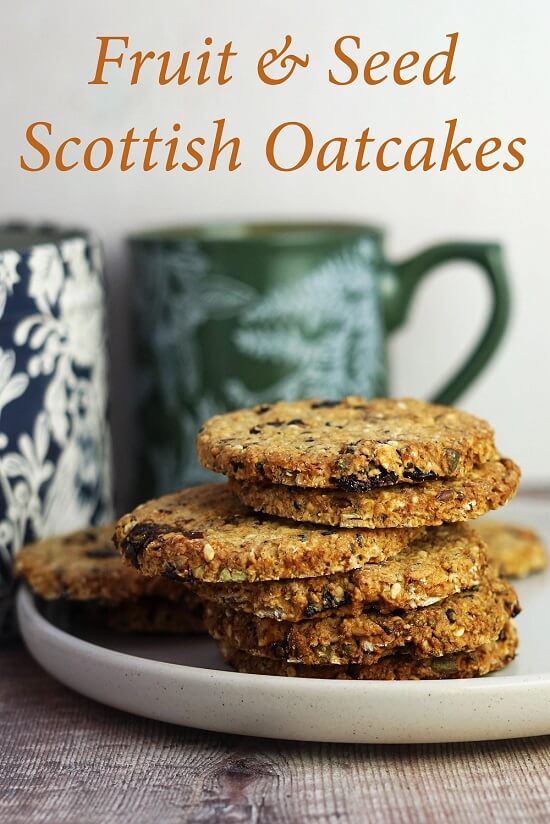Rosemary Scottish Oatcakes
Rosemary Scottish Oatcakes combine the aromatic Mediterranean herb with the traditional and well-loved savoury biscuit or cracker. Incredibly easy to make at home with just a handful of everyday ingredients, the oatcakes are the perfect partner to cheese, dips and spreads or alongside soups and salads.
In a nod to the herb’s origins, try rosemary oatcakes spread with soft cheese flavoured with garlic and rosemary, topped with chopped sun-dried tomatoes, olives and more rosemary. Delicious!

Disclosure: this post may contain affiliate links. If you buy via my links, I may earn a small commission at no extra cost to you.
Jump to Recipe
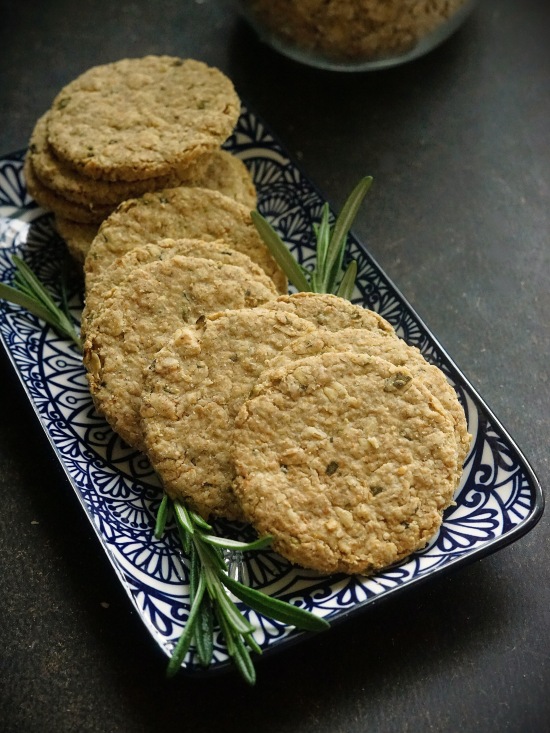
HOMEMADE SCOTTISH OATCAKES
They say you can’t have too much of a good thing. And that’s definitely true when it comes to the crackers or biscuits known as Scottish oatcakes. The perfect accompaniment to cheeses, pâtés, dips and spreads, this is the SIXTH recipe I’ve posted for them!
I started back in 2020 with classic Scottish Oatcakes. Containing just oats, salt, oil or butter, plus water, they’re head and shoulders above shop bought brands which often contain palm oil.
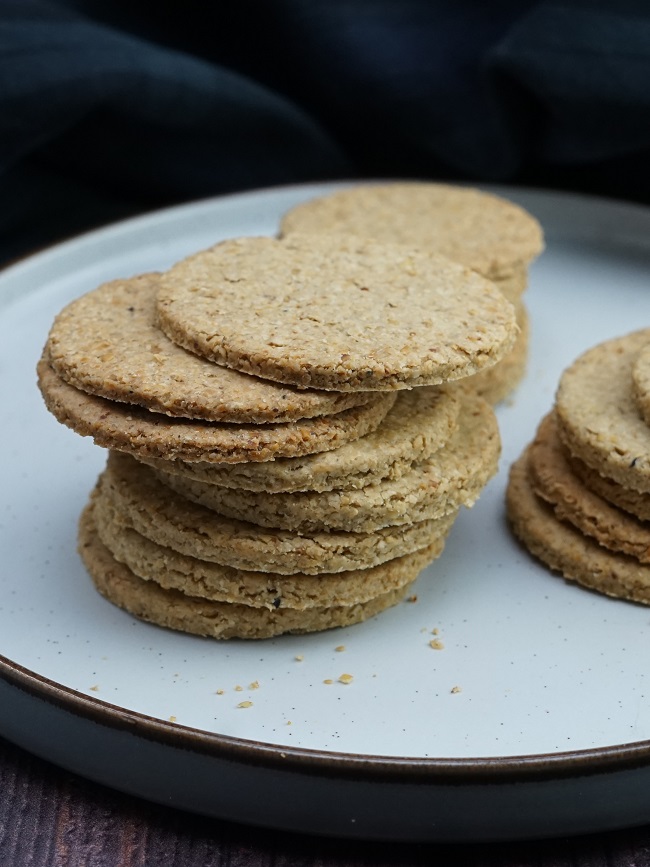
Once I discovered how easy and good homemade oatcakes were, I began to create different flavours. Cheesy Scottish Oatakes, Seeded Scottish Oatcakes, and Walnut & Pumpkin Seed Oatcakes were soon followed by a lightly sweet version: Fruit & Seed Oatcakes.
And now here’s my latest. Simple but beautifully flavoured Rosemary Scottish Oatcakes.
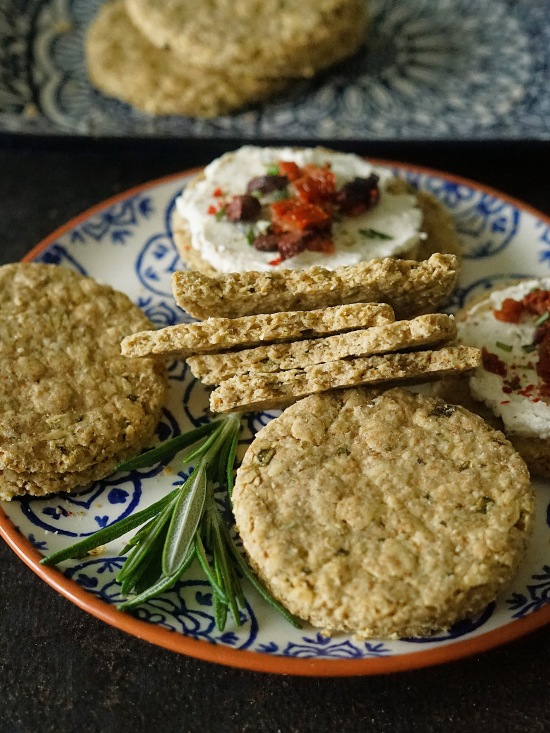
ROSEMARY SCOTTISH OATCAKES
I love the distinctive flavour and aroma of fresh rosemary. These are due to the compounds eucalyptol and alpha pinen. The herb has a long history of medicinal and spiritual use as well as in the kitchen, and while rosemary originated in the Mediterranean the evergreen shrub can usually be picked all year round in Britain.

A popular flavouring for biscuits and crackers, a couple of years ago I posted a recipe for Rosemary Crackers. Wonderfully light and crispy, I couldn’t help thinking that the same herb would work brilliantly in a rustic, wholesome Scottish oatcake. Now I’ve tried it I love the combination of aromatic Mediterranean herb and northern European wholegrain biscuit.
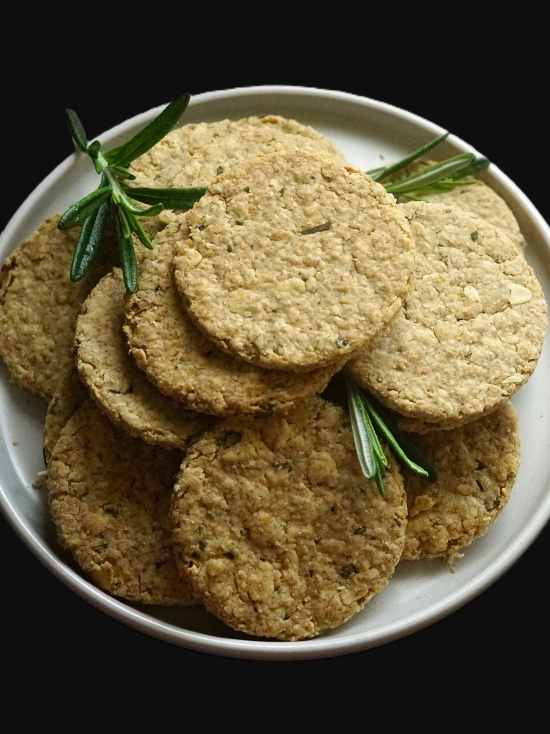
You’ll find ingredient amounts and full instructions in a recipe card at the end. But I recommend you read the whole of this post for extra tips and step-by-step images before you begin.
INGREDIENTS
The only ingredients you’ll need in addition to those for classic Scottish oatcakes (oats, salt, butter or oil, and water) are fresh rosemary and black pepper.
Oats. The oats you buy for cooking porridge are suitable for making oatcakes. Here in the UK, they’re labelled rolled (sometimes jumbo) or porridge oats. Rolled are larger and less flaky than porridge oats and will give you a coarser, more rustic oatcake.
Fine oatmeal. Alongside the oats, I include the same quantity of oatmeal. In Britain, oatmeal is simply a flour that’s made from oats (not the US breakfast dish which we call porridge). Sold as fine, medium, or coarse, oatmeal is easier to find in wholefood shops than supermarkets. But if you can’t find it, just make your own by whizzing up rolled or porridge oats in a blender or food processor until powdery.
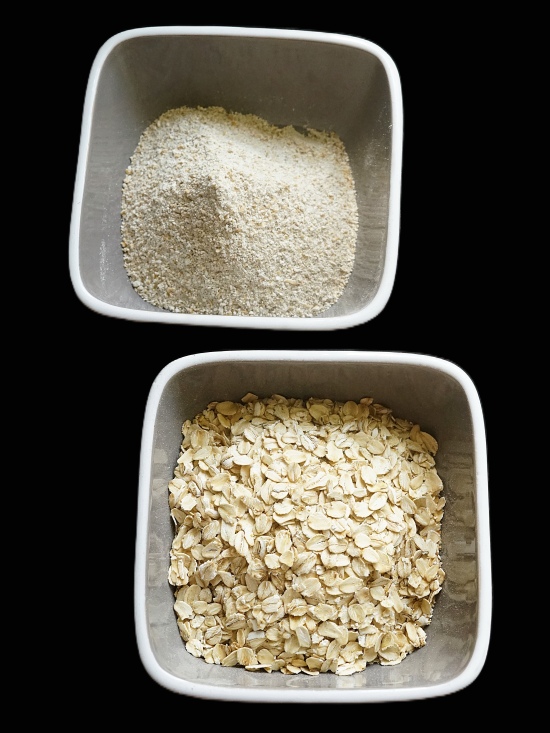
Butter or oil. I’ve made oatcakes with butter, olive oil, walnut oil, and hemp oil. There’s not an enormous difference to the end result, so choose whichever you prefer. For Rosemary Scottish Oatcakes I’ve opted for melted butter.
Fresh rosemary. Don’t be tempted to use dried rosemary; the lovely oils in the fresh herb will give you a much nicer oatcake. I use 4 rounded teaspoons of finely chopped rosemary which gives good flavour without being too strong. Tastes do vary though (and the amount of aromatic oils in any batch of the herb) so experiment with different amounts to suit you.
Salt and Black Pepper. Salt enhances all the flavours while the pepper gives a little warmth that complements the rosemary.
Wholemeal flour. This is for rolling out the dough. You could use more oatmeal, but flour is less sticky.
EQUIPMENT
Besides standard baking equipment like mixing bowl, silicone spoon, rolling pin, cookie cutter and baking trays, I highly recommend a silicone mat (paid link) for rolling out the dough. Useful for all kinds of baking, they’re particularly good for sticky doughs like those containing oats. And a mat makes cleaning up easier too.
For accuracy when baking, I always recommend you use digital scales (paid link) and follow my metric measurements. This is the way I create and test my recipes, so can’t vouch for the results if you attempt to convert them e.g. to American cups.
NOTE although you may know them just as ‘oatcakes’ I always refer to these savoury biscuits as ‘Scottish oatcakes’ because where I live ‘oatcake’ means Staffordshire Oatcakes: yeasted oat pancakes usually filled with bacon or sausage plus cheese and eaten for breakfast.
HOW TO MAKE ROSEMARY SCOTTISH OATCAKES
Making all kinds of Scottish oatcakes is quick and easy. There’s really only one thing to bear in mind: oats are very thirsty. This means that if you don’t add enough water then you will struggle to bring the dough together and roll it out. Similarly, if you use lots of flour (or even worse, lots of oatmeal) to roll out then you’ll probably need to add more water.
In short, if you don’t keep your dough moist you’ll be making things more difficult and your oatcakes could end up crumbly.
MIXING & ROLLING OUT THE DOUGH
To make the dough, start by stirring together the oats, fine oatmeal, salt, pepper, and finely chopped rosemary. Then make a well in the middle and add the melted butter (or oil) along with 100 ml of boiling water. Stir quickly to bring everything together to form a soft dough. If the dough looks at all dry, add more water without making it sloppy.
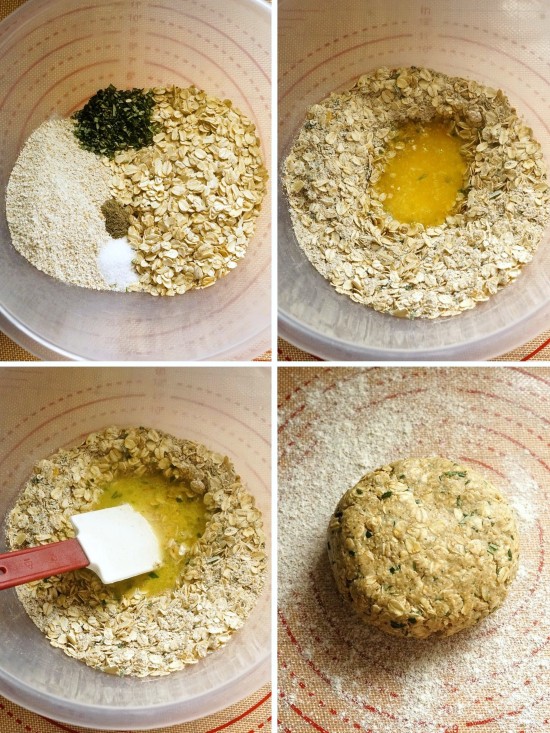
Sprinkle flour over your worksurface, ideally covered with a silicone mat, and put the ball of dough on it. Sprinkle the dough and your rolling pin with a little more flour and roll out to 3 mm for thin and crispy oatcakes, or up to 5 mm thick for crumblier ones. If you find the dough starts to come apart at the edges as you roll, just use your hands to push it back together and keep going. Remember: if it seems dry, sprinkle on more water.
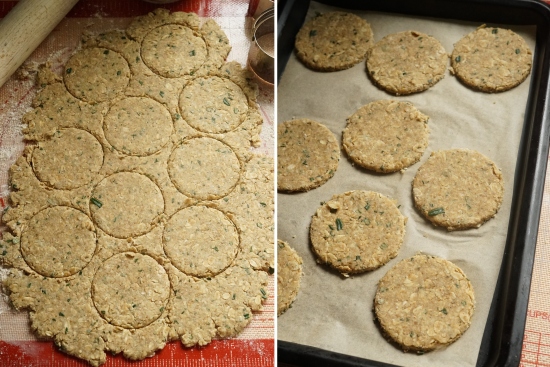
Take a round cutter, dipped in flour, to stamp out the oatcakes. I use a 7 cm cutter which usually gives me 20 in total. As you cut them out, transfer the oatcakes to paper-lined baking trays. Gather up the scraps and keep re-rolling and cutting out to make more oatcakes. Note: you will almost certainly need to add more water to the scraps to get them to come together again. The water doesn’t need to be boiling at this stage though.
BAKING & STORING
In an oven preheated to the temperature shown in the recipe card, the Rosemary Scottish Oatcakes will take approximately 30 minutes to bake. I cut out all the oatcakes first, then bake all together, swapping the trays over halfway through. For even baking, I also turn each one over for the final 10 minutes. If you rolled the dough more thickly, you may need to add a few minutes to the cooking time.

When done, the oatcakes should be a light golden brown: as they contain no sugar, don’t expect them to go deep golden brown. Cool on a wire rack and transfer to an airtight container once completely cold. If they’ve been thoroughly baked through and properly cooled, the oatcakes should keep for up to a month.
SERVING ROSEMARY OATCAKES
I love Scottish oatcakes with cheese, pâté or nut butters. But they were traditionally a major source of carbohydrate so would be served with all sorts of meals, taking the place of bread or toast at breakfast or alongside soups, including maybe Scotch Broth. However, in a nod to the herb’s Mediterranean origins, for these Rosemary Scottish Oatcakes I decided to pair them with some classic flavours of the region.
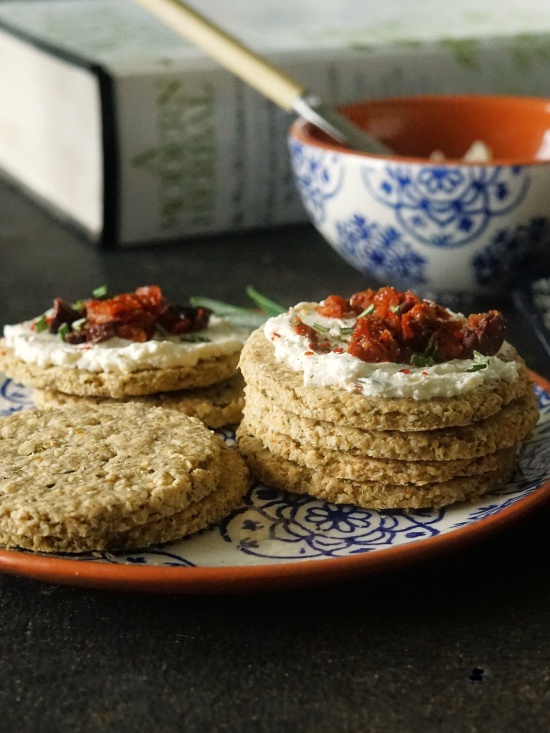
I took some plain soft cheese and beat in grated garlic, salt, black pepper, mild red pepper flakes and more finely chopped rosemary. Spread over oatcakes then topped with finely chopped sun-dried tomatoes and kalamata olives, plus more pepper and rosemary, they were an absolute knockout. The smooth, creamy cheese with its punchy additions was lovely against the pleasantly rough and rustic oatcakes.
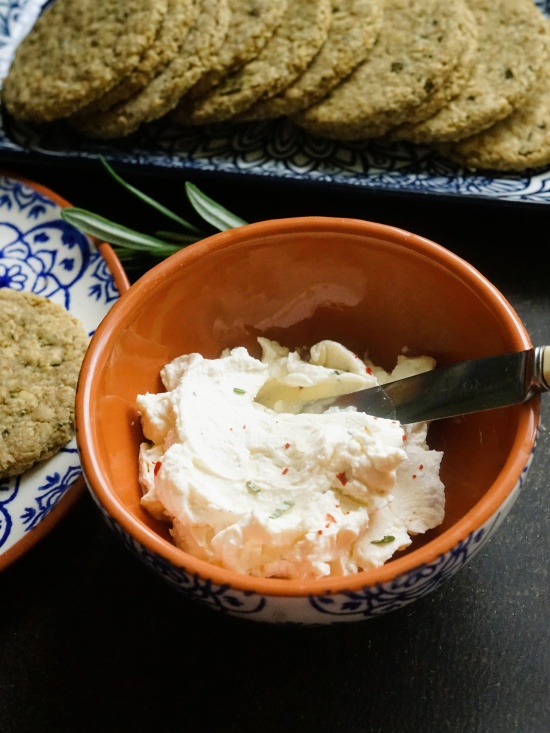
If you don’t have soft cheese, take a look at my simple recipe for Potted Cheese. In that post I show you how to combine grated hard cheese with butter and your chosen flavourings for a wonderful spread that goes great with oatcakes.
But almost any cheese or other savoury topping should work well with these versatile oatcakes.

If you’ve made my Rosemary Scottish Oatcakes I’d love to know what you thought. Please leave a comment and rating.
GET RECIPES STRAIGHT TO YOUR INBOX BY JOINING MY EMAIL LIST HERE
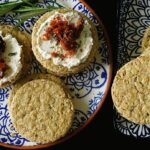
Rosemary Scottish Oatcakes
Incredibly easy to make with just a handful of everyday ingredients, oatcakes are the perfect partner to cheese, dips and spreads or alongside soups and salads.
In this version, the well-loved savoury biscuit or cracker is flavoured with aromatic rosemary: delicious spread with soft cheese flavoured with garlic and rosemary, topped with chopped sun-dried tomatoes, olives and more rosemary.
It's recommended you read the accompanying blog post before starting to cook. For the best results, use digital scales and metric measurements as these were used to test the recipe.
Ingredients
- 140 g rolled oats or porridge oats
- 140 g fine oatmeal (see Recipe Notes for making your own)
- 4 rounded tsp fresh rosemary leaves (finely chopped)
- ¾ tsp salt
- ¼ tsp black pepper
- 75 g butter, melted (or 75 ml oil e.g. olive)
- boiling water from a kettle
- wholemeal flour for rolling out (can be replaced with more oatmeal, but flour is recommended as it's less sticky)
Instructions
-
Preheat your oven to 180° C /160° Fan /Gas 4 /350° F.
Line 2 or 3 baking trays with baking paper.
-
Put the oats, oatmeal, rosemary, salt, and pepper in a mixing bowl and stir.
Make a well in the centre, pour in the melted butter or oil plus 100 ml of boiling water.
Stir quickly to bring everything together to form a soft dough. If the dough looks at all dry, add more boiling water without making it sloppy (see image in blog post for how it should look).
-
Sprinkle some wholemeal flour over your worksurface, ideally covered with a silicone mat, and put the ball of dough on it.
Sprinkle the dough and a rolling pin with a little more flour and roll out to 3 mm for thin and crispy oatcakes, or up to 5 mm thick for crumblier ones. If you find the dough starts to come apart at the edges as you roll, just use your hands to push it back together and keep going. If the dough seems at all dry, sprinkle with a little water: the key to success is keeping the dough moist.
-
Use a 7 cm cutter (or smaller if preferred) dipped in flour to stamp out oatcakes. As you cut them out, transfer the oatcakes to the paper-lined baking trays.
Gather up the scraps and keep re-rolling and cutting out to make more oatcakes. Note: you will almost certainly need to add more water to the scraps (cold water is ok) to bring them together.
-
Put the trays in the oven and bake until the oatcakes are completely cooked through and a light golden brown (approx. 30 minutes unless you rolled them particularly thinly or thick).
- if baking more than one tray at a time, swap shelves halfway through.
- for even baking, turn the oatcakes over for the final 10 minutes.
-
Cool on a wire rack and store in an airtight container once completely cold. Should keep for up to a month.
Recipe Notes
Oatmeal. You're more likely to find oatmeal in a wholefood store than a supermarket. However, you can easily make your own: whizz rolled oats or porridge oats in a food processor, blender, or coffee mill until fine.
RELATED RECIPES

